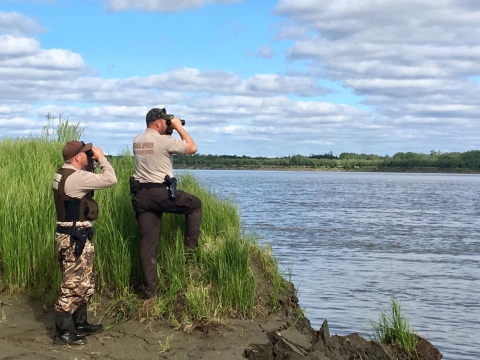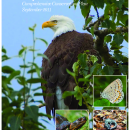What We Do
Wildlife conservation drives everything on U.S. Fish and Wildlife Service lands and waters, from the purposes for which a national wildlife refuge national wildlife refuge
A national wildlife refuge is typically a contiguous area of land and water managed by the U.S. Fish and Wildlife Service for the conservation and, where appropriate, restoration of fish, wildlife and plant resources and their habitats for the benefit of present and future generations of Americans.
Learn more about national wildlife refuge is established to the recreational activities offered to the resource management tools used. Using conservation best practices helps ensure the survival of native wildlife species. Refuges deploy a host of scientifically sound management tools to address biological challenges. These tools span active water management to wilderness character monitoring, all aimed at ensuring a balanced conservation approach to benefit both wildlife and people. At this field station our conservation tool box includes: Comprehensive Conservation Plan, Habitat Management, Climate Resilience, Conservation Easements, Compatibility Determinations, Cultural Resources, Education & Outreach, Fire Management, Invasive Species Management, Inventory and Monitoring, Law Enforcement, Pesticide Management, Recreation Management, Species Research, Water Management, Haying, Hunting, Commercial Forest Management and Furbearer Management. Find out more below!
Habitat Management
Historically, over 5,000 acres of the area that is now the refuge were flooded in the spring and mostly dry by summer, primarily due to man-made drainage programs. After the refuge was established, a system of dikes (man-made barriers) and water control structures were created to provide additional wetland habitat and help manage water levels throughout the year. Water levels are carefully managed to provide a variety of feeding, nesting, brood rearing, and resting habitats for migratory birds and resident wildlife including wading birds, shorebirds, songbirds, mammals, reptiles, amphibians, and others.
At one time, forests covered nearly all of western New York. Over time, these forests were cleared for agriculture purposes. Many forest loving species require large stands of forested habitat to survive. To fulfill this need, the refuge maintains several hundred acres of mature upland forest and occasionally we plant trees to reforest small openings adjacent to existing forest lands which creates larger forest blocks.
Early successional habitat (ESH) refers to grasslands, shrublands, and very young forests. The refuge maintains nearly 1500 acres of ESH through management such as mowing, haying, prescribed fire, mulching, discing, and planting. Many species, particularly birds, use ESH because it provides an abundance of food and nesting cover.
Inventory and Monitoring
Each year, refuge staff conduct habitat and population surveys to determine if we are providing the desired amount of wildlife habitat and to see what species of wildlife are using that habitat. Some surveys are conducted to gather information about what species occur on the refuge (e.g. insect surveys). Other surveys tell us more about how a species population is changing over time or how they react to habitat management practices (e.g., black tern surveys). Habitat surveys tell us if our habitat management objectives are being met. All these surveys provide us with information about the refuge lands and wildlife and help guide our future habitat management activities.
Research
The refuge is used as a living laboratory for staff and local researchers as there is still much to be learned about the species that inhabit it. Research projects that occur on the refuge can be as simple as capturing a few individual animals and taking some measurements or as involved as a multi-refuge habitat management research project spanning the entire northeast region and lasting several years. Professors and graduate students from local universities often use the refuge to collect data and answer questions. Research projects that have occurred on the refuge in the past have focused on species as inconspicuous as bacteria and as common as Canada geese. Past research has helped the refuge refine and improve many of our habitat management activities.
Visitor Services
Visitor Center
The Iroquois National Wildlife Refuge Visitor Center can be located at 1101 Casey Rd. Basom NY 14013. It is typically open Tuesday-Saturday from 9am-4pm but can fluctuate between seasons and staff availability, check our Facebook or feel free to call before you visit! Inside our Visitor Center you’ll find an array of interactive exhibits that tell you all about the refuge which include biological and historical artifacts, live fish, and an eagle nest camera. We also have bathrooms, a water fountain, binoculars and bird guides to borrow, and brochures/maps to take on your journey. The Friends of Iroquois National Wildlife Refuge also run the Flyway nature store which also has fluctuating hours based on volunteer availability, call ahead to confirm they’re open.
Programs and Events
Refuge staff, volunteers, and partners regularly host different programs and events throughout the year that enable visitors to connect to nature, wildlife, and the refuge lands. Our annual events include Spring Spectacular (May 10th, 2025), a celebration welcoming spring back to the swamps; Family Fishing Day (June 7th, 2025) a free day of fishing for the whole family with no permits required; and Veteran Family Fishing Day - a free fishing day for veterans and their families (July 12th, 2025). Check our events calendar HERE for updates on events and programs throughout the year! Reach out to logan_sauer@fws.gov to schedule a program, regardless if refuge staff support and accommodations are needed. We like to keep tabs on what goes on around the refuge to ensure everyone will have a smooth and uninterrupted experience.
Outreach
Outreach helps to inform and remind the public about the Refuge purpose and opportunities they can enjoy the refuge. You may see us at a fair, public exhibition, or festival spreading the word of Iroquois National Wildlife Refuge and the U.S. Fish and Wildlife Service. Contact logan_sauer@fws.gov if you would like us to attend your public program, event, or festival!
Buffalo Urban Wildlife Refuge Partnership
The Buffalo Urban Wildlife Refuge Partnership engages youth in learning about native wildlife and habitats, the Great Lakes and our surrounding watersheds, pollinators and gardens, while working on habitat restoration projects in the City of Buffalo! Read about our stories HERE.
Law Enforcement
Law enforcement officers work closely with state an local government offices to enforce federal, state and refuge hunting, fishing and trapping regulations that protect migratory birds and other game species from illegal take and preserve legitimate hunting, fishing and trapping opportunities. Some other duties include patrolling closed areas, maintaining relationships with neighboring landowners, search and rescue operations, maintaining refuge boundaries and participating in public events. If you see something, say something! Call the refuge at 585-948-5445 to report any suspicious activity.


